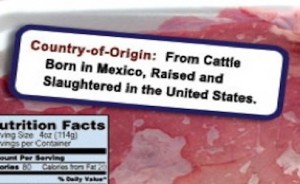 eement on Technical Barriers to Trade, say Canada and Mexico.
eement on Technical Barriers to Trade, say Canada and Mexico.The final rule, issued by the U.S. Department of Agriculture Thursday, might mean Canada and Mexico can begin imposing retaliatory tariffs. The American Meat Institute, National Cattlemen’s Beef Association, National Chicken Council, National Pork Producers Council, and the North American Meat Association all wanted USDA to work out a “sequencing agreement” with Canada and Mexico to avoid triggering retaliatory action.
With or without retaliatory tariffs, AMI’s Mark Dopp says the new rule is “more costly, complex and burdensome” than what it replaces. And he says our trading partners have made it clear that the new rule is “no fix,” and shows a reckless disregard for trade relations.
A sequencing agreement would have allowed time for WTO to review the meat labeling changes. Canada alone is set to impose retaliatory tariffs costing U.S. producers more than $1 billion a year.
“USDA remains confident that these changes will improve the overall operation of the program and also bring the mandatory COOL requirements into compliance with U.S. international trade obligations,” said Secretary of Agriculture Tom Vilsack.
According to USDA, the final rule modifies the labeling provisions for muscle-cut covered commodities to require the origin designations to include information about each of the production steps, such as where an animal was born, where it was raised, and where it was slaughtered. The rule removes the allowance for commingling of muscle cuts.
Thursday was the deadline for the U.S. to comply with a June 2012 decision by the WTO Appellate Body that confirmed an earlier WTO panel decision finding that certain aspects of the COOL law discriminated against livestock imports from Canada and Mexico. The U.S was required by the WTO Appellate Body to bring COOL into compliance with the Agreement on Technical Barriers to Trade.
Some farm and consumer groups hailed the USDA action. “We are very pleased that the USDA has decided to stand strong and keep COOL,” said National Farmers Union (NFU) President Roger Johnson. “The decision to bring the law into compliance with the WTO’s ruling is a win-win situation for all interested parities.”
Johnson applauded USDA for taking a “proactive approach” and not allowing COOL to be watered down by process. Likewise the consumer-oriented group Food & Water Watch hailed USDA for a rule “that makes sensible changes for labeling requirements for meat.”
F&WW said there is a growing interest among consumers in knowing where their food comes from. The group also says the changes should satisfy the WTO. The largest producer-only cattle trade association in the U.S., the Billings, MT-based Ranchers-Cattlemen Action Legal Fund, United Stockgrowers of America (R-CALF USA) agrees.
“USDA’s final rule is right on the mark,” said R-CALF USA COOL Committee Chair Mike Schultz, adding, “We are pleased that USDA did not weaken COOL in response to the WTO’s attack on our domestic food labeling program.”
“By requiring the locations where each production step occurs to be listed on the label, the final COOL rule addresses the WTO’s criticism by requiring all the information collected from cattle suppliers to be transmitted to consumers,” Schultz explained.
Schultz said the final COOL rule also ensures that labels are accurate by putting an end to the industry practice of using a multi-country label on meat derived exclusively from animals born, raised, and slaughtered in the United States when a meatpacker comingles any amount of foreign product during a production day.
“By correcting this huge loophole, the final rule restores the credibility of our labeling program and provides consumers with accurate origin information,” Schultz said.
R-CALF USA CEO Bill Bullard explained that COOL is necessary to facilitate competition for U.S. cattle and provide choices for U.S. consumers.
“Without COOL it is the meatpacker and not the consumer that decides from what country cattle will be sourced to satisfy consumer demand for beef. Only with COOL can consumers trigger a demand signal for cattle sourced from U.S. farmers and ranchers, which they can do simply by consistently choosing to purchase a USA product,” concluded Bullard.
The final COOL rule is being published in the Federal Register today (May 24, 2013). It became effective yesterday. USDA’s Agricultural Marketing Service (AMS) is responsible for implementation, administration and enforcement of the COOL law and regulations. Country of origin labeling is required for various food products, including fruits, vegetables, fish, shellfish, and meats. AMS will be conducting education and outreach programs on the COOL rule changes.
According to USDA, more than 3,800 retailer reviews have been conducted since the COOL law took effect on May 16, 2009 and about 98 have been found to be in compliance.
Only the rules for meat were challenged by Canada and Mexico at the WTO.




